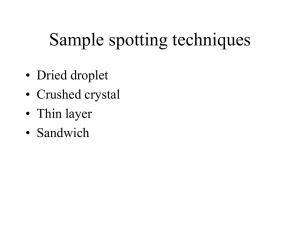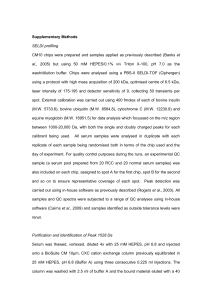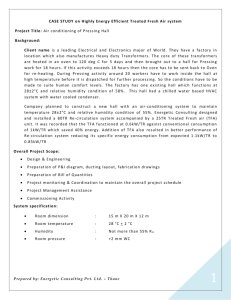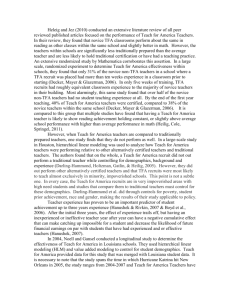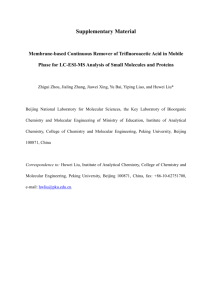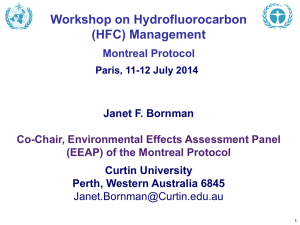Signal_processing_for_quantifying_autoregulation
advertisement
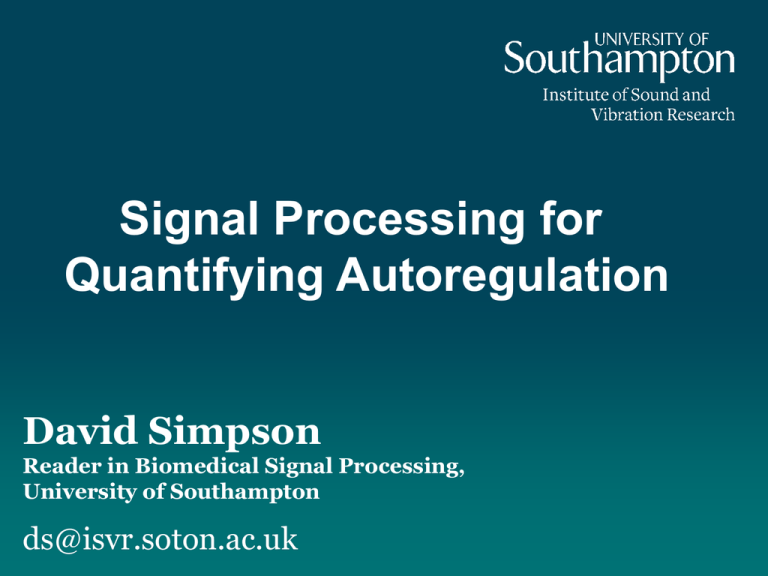
Signal Processing for Quantifying Autoregulation David Simpson Reader in Biomedical Signal Processing, University of Southampton ds@isvr.soton.ac.uk Outline • Preprocessing • Transfer function analysis – Gain, phase, coherence – Bootstrap project • Model fitting • Extracting parameters • Discussion 2 blood flow velocity original 20 10 0 blood flow velocity -10 0 10 time (s) 20 20 cm/s cm/s Median filter original median filtered 10 0 -10 10 12 time (s) 14 5 Median filter blood flow velocity 10 0 blood flow velocity -10 0 10 time (s) 20 20 cm/s cm/s 20 original median filtered original median filtered 10 0 • Can not remove wide spikes • Right-shift of signal -10 18 18.2 time (s) 18.4 6 blood flow velocity original 20 10 filtered velocity 0 -10 0 original median filtered 8 10 time (s) 20 cm/s cm/s Smoothing 6 4 • Bidirectional low-pass (Butterworth) filter, fc=0.5Hz 2 • Ignore the beginning! 0 5 10 15 time (s) 20 25 7 Transfer function analysis (TFA) raw signals 25 p v 20 • Data from Bootstrap Project • Normalized by mean • Not adjusted for CrCP 15 % 10 5 0 -5 -10 -15 0 50 100 150 time (s) 200 250 300 Thanks: CARNet bootstrap project for data used 8 Transfer function analysis (TFA) raw signals 15 % 10 • Filtered 0.03-0.5 p v 5 0 -5 0 100 200 time (s) 300 9 Relating pressure to flow Transfer function (frequency response) V(f)=P(f).H(f) 10 Blood Flow Velocity Arterial Blood Pressure error Input / output + model End-tidal pCO2 Fourier Series Periodic Signals - Cosine and Sine Waves Period T=1/f 4 Cosine wave 2 Sine wave 0 -2 -4 0 11 t 0.5 1 time (s) 1.5 2 x (t ) a. cos(2ft ) Gain TFA gain 3 2 1 0 0 0.1 0.2 0.3 0.4 frequency (Hz) 12 Phase TFA phase 2 0 -2 0 0.1 0.2 0.3 0.4 frequency (Hz) 13 Coherence How well are v and p correlated, at each frequency? |coherence| TFA 0.8 0.6 0.4 0.2 0 0.1 0.2 0.3 0.4 frequency (Hz) 14 Power spectral estimation: Welch method An example from EEG x window x.window signal 1 0 -1 0 0.5 1 time (s) Detail 0 -1 0 16 0.03 PSD signal 1 0.02 0.01 0.2 0.4 time (s) 0 20 40 frequency (Hz) Power spectral estimation: Welch method x window x.window signal 1 0 -1 0 0.5 1 time (s) Detail PSD signal 1 0 -1 0.4 0.6 time (s) 17 0.04 0.03 0.02 0.01 0 20 40 frequency (Hz) Power spectral estimation: Welch method x window x.window signal 1 0 -1 0 0.5 1 time (s) Detail 0.04 0.03 PSD signal 1 0 -1 0.01 0.6 18 0.02 0.8 time (s) 0 20 40 frequency (Hz) Power spectral estimation: Welch method signal 1 0 -1 0 0.5 1 time (s) Detail 0.06 PSD signal 1 0 -1 0.8 19 1 time (s) 1.2 0.04 0.02 0 20 40 frequency (Hz) Power spectral estimation: Welch method signal 1 0 -1 0 0.5 1 time (s) Detail 0.15 0 -1 1 20 PSD signal 1 1.2 1.4 time (s) 0.1 0.05 0 20 40 frequency (Hz) Power spectral estimation: Welch method. Averaging individual estimates 0.15 PSD 0.1 0.05 0 10 20 30 frequency (Hz) TFA analysis: 21 40 Estimated cross-spectrum between p and v Estimated auto-spectrum of p TFA 3 T=100s T=20s 2 TFA 1 2 0 0.1 0.2 0.3 0.4 frequency (Hz) • Frequency resolution: Δf=1/T, T… duration of window phase gain Changing window-length 0 -2 0 0.1 0.2 0.3 0.4 frequency (Hz) 22 Estimating spectrum and cross-spectrum • Frequency resolution: Δf=1/T, T… duration of window • Estimation error: with more windows • Compromise: Longer windows: better frequency resolution, worse random estimation errors • Higher sampling rate increases frequency range • Longer FFTs: interpolation of spectrum, transfer function, coherence … • Window shape: probably not very important 24 Effect of windowlength (M) and number of windows (L) 4 Signal: N=512, fs=128 PSD With fixed N (512), type of window (rectangular), and overlap (50%) 3 M=128 L=? f=? 2 1 0 True estimates 10 6 4 M=512 L=? f=? 1.5 PSD PSD 8 2 0 25 1 0.5 10 20 frequency [Hz] 10 20 frequency [Hz] 30 M=64 L=? f=? Mean of estimates 30 0 10 20 frequency [Hz] 30 Critical values for coherence estimates • 3 realizations of uncorrelated white noise Critical value (3 windows, α=5%) TFA coherence |coherence| 0.8 0.8 0.6 0.4 0.4 0.2 0.2 0 0.6 0.1 0.2 0.3 0.4 frequency (Hz) 0 0.5 1 1.5 frequency (Hz) 2 26 Critical values 2 No. of independent windows C crit 0.8 0.6 10% 5% 1% 0.4 0.2 0 20 40 no. windows 27 Modelling Arterial Blood Pressure End-tidal pCO2 Adaptive Input / output model Blood Flow Velocity error + 29 Step responses Predicted response to step input (13 recordings, normal subjects) 1.5 % 1 0.5 0 -0.5 -1 -2 0 2 4 time (s) 6 830 pressure pulse response Predicted response to change in pressure 2 1 0 -1 -10 9 April 2015 -5 0 time (s) 5 10 31 How to quantify autoregulation from model SDn Inter-subject variability mSDn Intra-subject variability o 120 % 100 o o * o * 80 o 60 * * * o + + + 40 20 0 Mx Pha Coh ARI H1 L NL FVS L NL L PCS Autoregulatory Parameter NL A1.5 L NL A7 32 Alternative estimator: FIR filter impulse response TFA FIR 1 0 -1 3 • • • • -5 0 time (s) 5 Sampling frequency (2 Hz) Scales are not compatible TFA: not causal Needs pre-processing 10 gain -10 TFA FIR filter 2 1 0 0 0.1 0.2 0.3 0.4 frequency (Hz) 33 Change cut-off frequency (0.03-0.8Hz) impulse response TFA FIR 1 0.5 3 TFA FIR filter -10 -5 0 time (s) 5 gain 0 2 10 1 0 0 0.1 0.2 0.3 0.4 frequency (Hz) 34 ARI step responses %/% 1 Increasing ARI 0.5 0 0 5 time (s) 10 35 Selecting ARI: best estimate of measured flow measured estimated v 5 0 -5 30 40 time (s) 50 60 36 Non-linear system identification LNL Model Pressure Linear NonLinear Linear Filter Static Filter Flow 37 Summary • Proprocessing • TFA – Gain, phase, coherence – Window-length – Critical values for coherence • Issues – What model? – Frequency bands present – How best to quantify autoregulation from model 38
